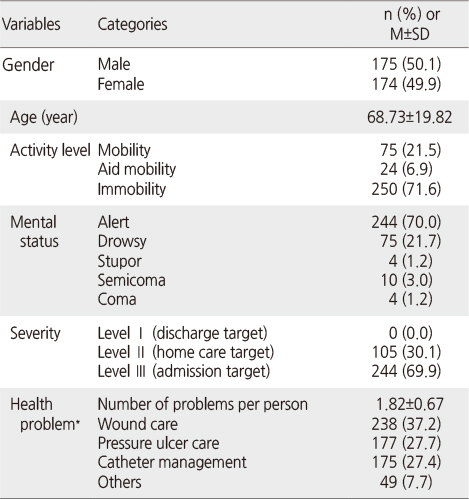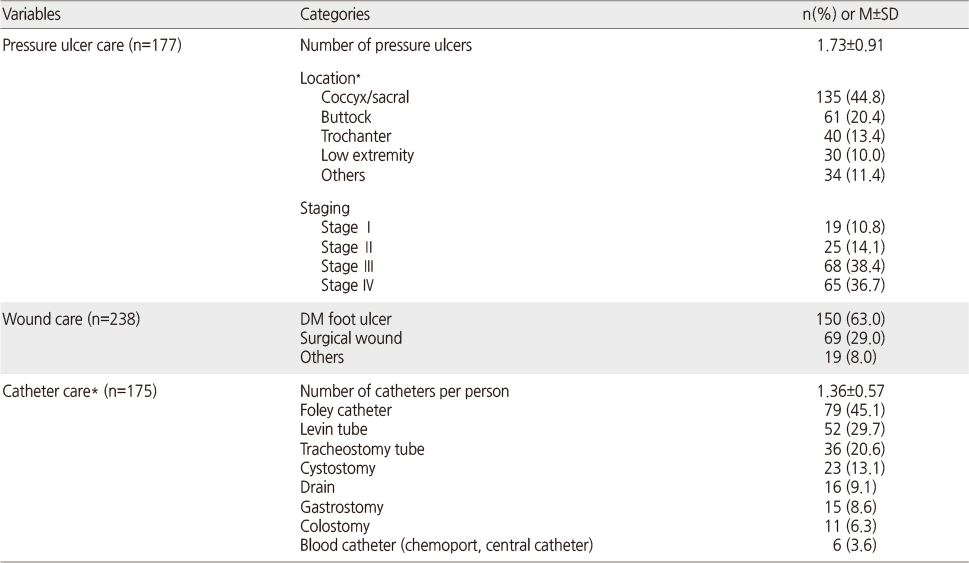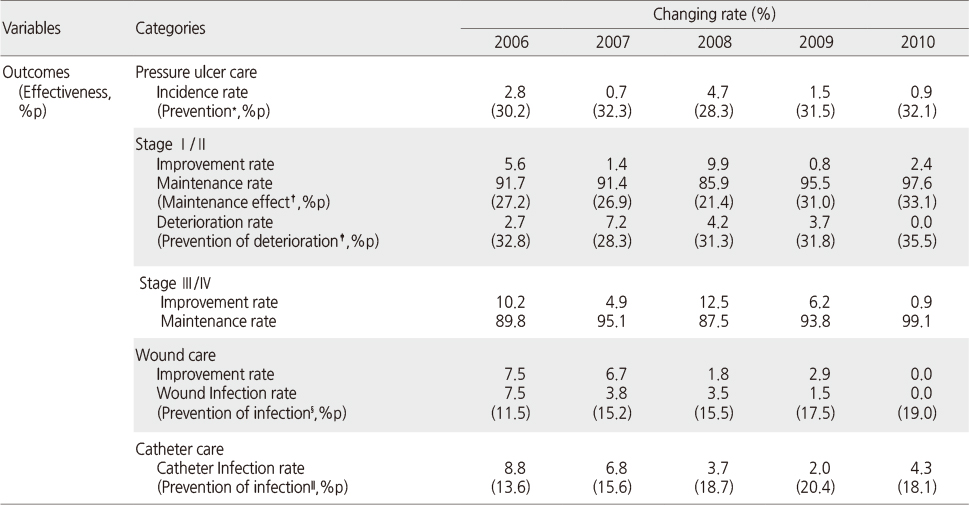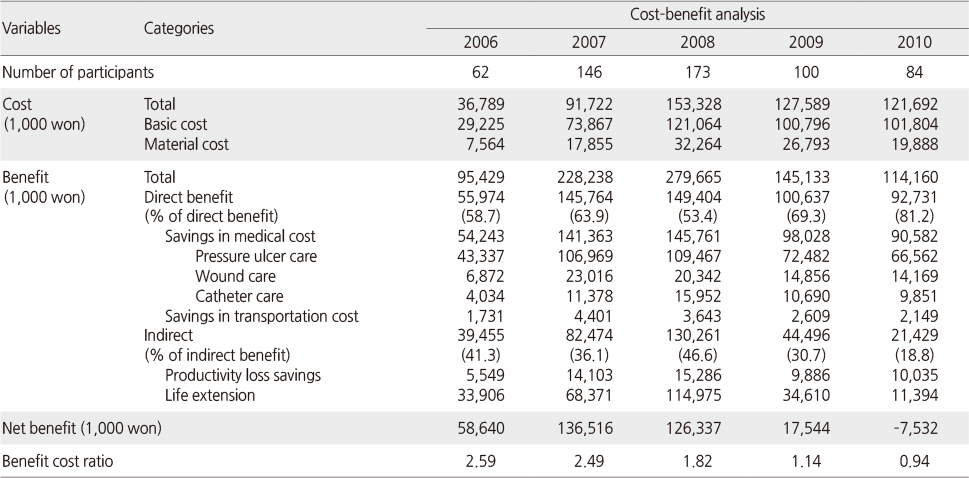Articles
- Page Path
- HOME > J Korean Acad Nurs > Volume 46(4); 2016 > Article
-
Original Article
- Economic Effect of Home Health Care Services for Community-dwelling Vulnerable Populations
- Eunhee Lee, Jinhyun Kim
-
Journal of Korean Academy of Nursing 2016;46(4):562-571.
DOI: https://doi.org/10.4040/jkan.2016.46.4.562
Published online: August 31, 2016
1Division of Nursing, Hallym University, Chuncheon, Korea.
2College of Nursing, The Resrarch Institute of Nursing Science, Seoul National University, Seoul, Korea.
- Address reprint requests to: Kim, Jinhyun. College of Nursing, The Resrarch Institute of Nursing Science, 103 Daehak-ro, Jongno-gu, Seoul, 03080, Korea. Tel: +82-2-740-8818, Fax: +82-2-766-1852, jinhyun@snu.ac.kr
© 2016 Korean Society of Nursing Science
This is an Open Access article distributed under the terms of the Creative Commons Attribution NoDerivs License. (http://creativecommons.org/licenses/by-nd/4.0/) If the original work is properly cited and retained without any modification or reproduction, it can be used and re-distributed in any format and medium.
Abstract
-
Purpose
- In this study the costs and benefits of a home health care program were examined to evaluate the economic feasibility of the program.
-
Methods
- The study participants included 349 patients in the community who had been registered at a home health care center for 5 years. The costs and benefits of the program were analyzed using performance data and health data. The benefits were classified as the effects of pressure ulcer care, skin wound care and catheters management. The program effect was evaluated on the change of progress using transition probability. Benefits were divided into direct benefit such as the savings in medical costs and transportation costs, and indirect benefits which included saving in productivity loss and lost future income.
-
Results
- Participants had an average of 1.82 health problems. The input cost was KRW 36.8~153.3 million, the benefit was KRW 95.4~279.7 million. Direct benefits accounted for 53.4%~81.2%, and was higher than indirect benefits. The net benefit was greater than 0 from 2006 to 2009, and then dropped below 0 in 2010.
-
Conclusion
- The average net benefit during 5 years was over 0 and the benefit cost ratoi was over 1.00, indicating that the home health care program si economical.
This manuscript is a revision of the first author's doctoral dissertation from Seoul National University.
The study was funded by the Research Grant of Hallym University.
The authors declared no conflict of interest.
- 1. Ryu H. Home health care in Korea: Home health care nursing, visiting health care nursing, visiting health care. J Korean Acad Soc Home Care Nurs. 2007;14(2):98–105.
- 2. Sanford DE, Olsen MA, Bommarito KM, Shah M, Fields RC, Hawkins WG, et al. Association of discharge home with home health care and 30-day readmission after pancreatectomy. J Am Coll Surg. 2014;219(5):875–886.e1. ArticlePubMedPMC
- 3. Health Quality Ontario. In-home care for optimizing chronic disease management in the community: An evidence-based analysis. Ont Health Technol Assess Ser. 2013;13(5):1–65.
- 4. Lee T. Community-based home healthcare project for Korean older adults. Osong Public Health Res Perspect. 2013;4(5):233–239. ArticlePubMedPMC
- 5. Lee E, Park S. A study on the operating status of community-based home health care centers. J Korean Acad Nurs Adm. 2011;17(2):180–188. Article
- 6. Kwon MY, Lim JY, Lee YW, Kim HS. A study of nurses' perception of the visiting nursing services of long-term care insurance. J Korean Public Health Nurs. 2010;24(1):5–18.
- 7. Lee JS, Hwang RI, Han EJ. Trends in home-visit nursing care by agencies' characteristics under the national long-term care insurance system. J Korean Acad Community Health Nurs. 2012;23(4):415–426.Article
- 8. Lee JS, Han EJ, Kang IO. The characteristics and service utilization of home nursing care beneficiaries under the Korean long term care insurance. J Korean Acad Community Health Nurs. 2011;22(1):33–44. Article
- 9. Kim H, Kwon S, Yoon NH, Hyun KR. Utilization of long-term care services under the public long-term care insurance program in Korea: Implications of a subsidy policy. Health Policy. 2013;111(2):166–174. ArticlePubMed
- 10. Park JY, Ko SK. Cost-benefit analysis of the community-based home health care program. Korean J Health Econ Policy. 2000;6(2):203–245.
- 11. Kim SY, Park SA. A study for evaluating the performance of a community-based home care services model. J Korean Acad Community Health Nurs. 2008;19(4):673–683.
- 12. Welton NJ, Ades AE. Estimation of markov chain transition probabilities and rates from fully and partially observed data: Uncertainty propagation, evidence synthesis, and model calibration. Med Decis Mak. 2005;25(6):633–645. ArticlePDF
- 13. Perez ED. Pressure ulcers: Updated guidelines for treatment and prevention. Geriatrics. 1993;48(1):39–44.
- 14. Sato M, Sanada H, Konya C, Sugama J, Nakagami G. Prognosis of stage I pressure ulcers and related factors. Int Wound J. 2006;3(4):355–362. ArticlePubMedPMC
- 15. Landi F, Onder G, Russo A, Bernabei R. Pressure ulcer and mortality in frail elderly people living in community. Arch Gerontol Geriatr. 2007;44:Suppl 1. 217–223. ArticlePubMed
- 16. Towfigh S, Clarke T, Yacoub W, Pooli AH, Mason RJ, Katkhouda N, et al. Significant reduction of wound infections with daily probing of contaminated wounds: A prospective randomized clinical trial. Arch Surg. 2011;146(4):448–452. ArticlePubMed
- 17. Guanche-Garcell H, Requejo-Pino O, Rosenthal VD, Morales-Pérez C, Delgado-González O, Fernández-González D. Device-associated infection rates in adult intensive care units of Cuban university hospitals: International nosocomial infection control consortium (INICC) findings. Int J Infect Dis. 2011;15(5):e357–e362. ArticlePubMed
- 18. Health Insurance Review & Assessment Service. 2006-2010 medical utilization[Internet]. Seoul, Author. 2011;cited 2014 August 3. Available from: http://opendata.hira.or.kr/op/opc/olapHthInsRvStatInfo.do
- 19. Ministry of Health & Welfare and Family Affairs. Korea Center for Disease Control & Prevention. Korea health statistics 2005: Korea national health and nutrition examination survey (KNHANES III). Seoul: Korea Center for Disease Control & Prevention; 2006.
- 20. Ryu H. Current status of costs and utilizations of hospital based home health nursing care in Korea. J Korean Acad Nurs. 2006;36(7):1193–1203.ArticlePDF
- 21. June KJ, Park JY. Cost-effectiveness analysis of home health care program for cerebrovascular accident patients. J Korean Community Nurs. 2001;12(1):22–31.
- 22. Kim MJ. Cost analysis of community-based home health care (HHC) versus hospital-based home health care (HHC)[master's thesis]. Seoul, Yonsei University. 2000;1–74.
- 23. Kim J, Lee T, Lee J, Shin S, Lee E. A cost benefit analysis of individual home visiting health care. J Korean Acad Community Health Nurs. 2010;21(3):362–373. Article
- 24. Im MJ, Park HS. A study on the pressure ulcers in neurological patients in intensive care units. J Korean Acad Fundam Nurs. 2006;13(2):190–199.
- 25. Gunningberg L, Stotts NA, Idvall E. Hospital-acquired pressure ulcers in two Swedish county councils: Cross-sectional data as the foundation for future quality improvement. Int Wound J. 2011;8(5):465–473. ArticlePubMedPMC
- 26. Sturkey EN, Linker S, Keith DD, Comeau E. Improving wound care outcomes in the home setting. J Nurs Care Qual. 2005;20(4):349–355. ArticlePubMed
- 27. Rodrigues I, Mégie MF. Prevalence of chronic wounds in Quebec home care: An exploratory study. Ostomy Wound Manage. 2006;52(5):46–48. 5052–57.
- 28. Kübler A, Duszynska W, Rosenthal VD, Fleischer M, Kaiser T, Szewczyk E, et al. Device-associated infection rates and extra length of stay in an intensive care unit of a university hospital in Wroclaw, Poland: International nosocomial infection control consortium's (INICC) findings. J Crit Care. 2012;27(1):105.e5–105.e10. ArticlePubMed
- 29. Vonberg RP, Behnke M, Geffers C, Sohr D, Ruden H, Dettenkofer M, et al. Device-associated infection rates for non-intensive care unit patients. Infect Control Hosp Epidemiol. 2006;27(4):357–361. ArticlePubMed
REFERENCES
Figure & Data
REFERENCES
Citations

- Examining Characteristics and Service Utilization of South Korean Home Health Care Patients: Secondary Analysis of 10-Year Data From a Tertiary Hospital
Hana Lee, Aeri Kim, Hyunsook Heo, Jisoo Lee, Kyungmi Woo
Home Health Care Management & Practice.2023; 35(1): 21. CrossRef - Economic Evaluation of Hospital-based Home Care Services for the Breast Cancer Surgery Patients
Jeong Yeon Ko, Ju Young Yoon
Journal of Korean Academy of Community Health Nursing.2021; 32(3): 356. CrossRef - Evolving Changes in the Delivery of Health Services: A Place for Urological Homecare?
Khalid Al Rumaihi, Stephen A. Boorjian, Michael Jewett
European Urology.2019; 75(4): 543. CrossRef
Characteristics of Participants and Health Status at Initial Enrollment (N=349)
*Multiple answers were allowed.
Characteristics of Deaths (N=349)
Characteristics of Participants' Health Problem
*Multiple answers were allowed.
Effectiveness of Home Health Care Service
*Prevention=33.0% [15]–incidence rate;†Maintenance effect=maintenance rate–64.5% [16];‡Prevention of deterioration=35.5% [16]–deterioration rate; §Prevention of wound infection=19% [17]–Infection rate; ||Prevention of catheter infection=22.4% [18]–Catheter Infection rate.
Cost–benefit Analysis of Home Care Service
*Multiple answers were allowed.
*Multiple answers were allowed.
*Prevention=33.0% [
 KSNS
KSNS
 E-SUBMISSION
E-SUBMISSION





 Cite
Cite

